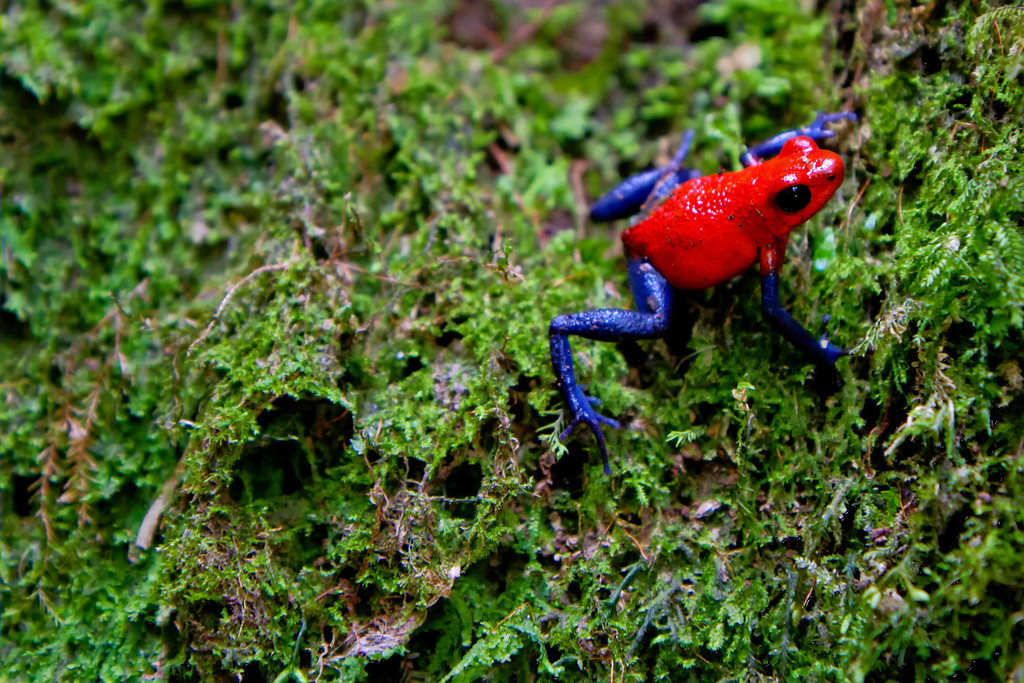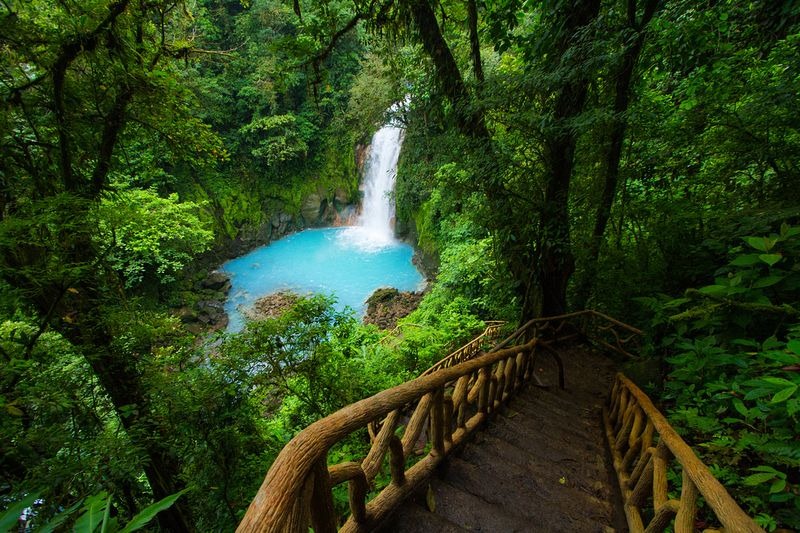Once upon an ancient time, a god decided to paint the sky. Blue, he said, as he picked up his brush – the sky shall be blue. And so, the god chose his paints and began to smear the sky in swaths of cerulean, sapphire and turquoise.
As he painted, the god reached down to Earth to clean his brush. And his brush touched a river. And thus, the river also turned blue – sky blue, as the hue would be known, after the god finished his work. The Celeste River, as the river would be known, one day.
Or so the story goes.
Of course, there's a scientific explanation for Costa Rica's Rio Celeste. One that has everything to do with volcanic minerals – with oxygen, aluminum, and silicon, suspended in water and refracting light.
But we prefer the more romantic explanation. It's fitting for this special river, baby blue in hue and proof, if ever there were, of real-life alchemy – of the mundane becoming something magical. Because here, the water is really, truly blue. Scoop it up with your hands – blue. Immerse your arm – blue. The Rio Celeste is really, truly the blue of a sky-blue crayon. Of a god's leftover sky paint.
If we are vague, let us be clear: Don't miss this Tamarindo day trip. Just don't!

Well, what you should know beyond the obvious – beyond the fact that you're about to experience one of the world's most memorable, most unique sights! Here are a few considerations:
Rio Celeste is not just a river: this baby-blue body of water is surrounded by exuberant rain forest – a biodiverse, richly hued sight in its own right. And then, there's Tenorio Volcano, home to four volcanic cones and spectacular panoramas that stretch from the Pacific to the Caribbean. But for most, Tenorio Volcano National Park is all about the Celeste River. That's why we're here, at least. To whit:
Rio Celeste River & Waterfall Overview:
Location: 25 minutes southeast of Bijagua, via a partially paved road Founded: April 27, 1995 Maximum Altitude: 6,286 feet above sea level Area: 45,475 acres Hours: Entrance between 8 a.m. and 2 p.m., every day; you may remain in the park until 4 p.m. Services Available: Potable water, restrooms, a mirador/lookout point, and parking (¢1,000). Telephone: 2200-0135 Entrance Fee: $12 adults / $5 children (ages 2-12) Parking: ¢1,000What You Should Know:

Well, what you should know beyond the obvious – beyond the fact that you're about to experience one of the world's most memorable, most unique sights! Here are a few considerations:
- Dry season is crowded: Rio Celeste is one of Costa Rica's most photographed sights, which means that travelers flock here in droves. In dry/high season months (typically, January through April), the park can fill up fast. And that's important because...
- Tenorio Volcano National Park limits visitors: To better the traveler experience, the national park now limits visitors to 1,200 per day, with only 400 allowed on the trails at any given time. So, arrive early, not only so you make it in, but also so you don't have to wait for the early-birds to finish their hikes.
- Sections may close due to weather: Certain trails and sectors of the park close during extreme (think: downpours, excessive mud, etc.) weather. Check the Rio Celeste Facebook pagefor current conditions.
- You can't swim in the park (but you also kind of can): Swimming is prohibited within the national park. That said, you can swim at the public entrance, located about 1 kilometer past the park entrance.
- For best photo ops, visit during the dry season (or late morning): If you're hoping for the bluest of blues, visit during the height of the dry season (January-April), when the river runs clear of sediment. But don't worry; Rio Celeste still flows blue during the rainy season – just not as For best colors in rainy season, visit late morning, to give the river a chance to filter out sediment.
What to Wear & Pack:
Tenorio Volcano National Park is one of Costa Rica's more rugged, with weather that can change on a dime (or a ¢50 coin!). If you get stuck in a rainstorm, you may hit extreme mud – we're talking the kind that sucks at your boots and makes you work for every step – so it's always best to arrive prepared. Here's what's in our daypack:- Water: ALL the water! Temperatures at the park climb into the mid-80s during the day; with humidity (and challenging hiking), you'll sweat a lot and should drink even more.
- Snacks: Refuel! Trust us. It can be a long hike.
- Hiking shoes: We highly recommend hiking shoes or boots, preferably of the waterproof variety, for hiking in any of Costa Rica's national parks. If you don't pack them, you can rent rubber boots for about $5 outside the park entrance. These aren't the most comfortable boots, though; it's better to bring your own.
- Comfortable clothes: While you don't strictly needhiking clothes or long pants, you may want them for the extra protection they afford from mosquitoes and other bugs. That said, at the very minimum you'll want comfortable, quick-dry clothes, if you're walking through the river. (It's about mid-thigh deep!)
- Rain protection: If you're visiting during potentially rainy months (to be safe, April-December), you'll want a heavy poncho, electronics wetbag, and water-resistant daypack, to keep yourself and your gear dry.
- Hiking poles: The park's trails are rugged and can get slippery. When in doubt, pack your hiking poles.
- Swimming gear: If you're stopping at the public swimming area before or after your hike, you'll want a swimsuit and towel. Beware, the water is cold!
- Bug repellent: You may not need it but if you do, you don't want to be stuck mid-hike without it!
Attractions

Rio Celeste is not just a river: this baby-blue body of water is surrounded by exuberant rain forest – a biodiverse, richly hued sight in its own right. And then, there's Tenorio Volcano, home to four volcanic cones and spectacular panoramas that stretch from the Pacific to the Caribbean. But for most, Tenorio Volcano National Park is all about the Celeste River. That's why we're here, at least. To whit:


